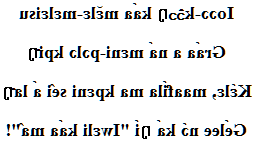Kpelle love poem
Ioɔɔ-kɔ̂ɔŋ káa mɛ̆lɛ-mɛlɛisu
Gráa a ná mɛni-pɔlɔ kpîŋ
Kɛ́lɛ, maafíla ma kpɛni sêi á lâŋ
Gélee nɔ́ ká ŋí "Iwɛli káa mâ"!


→ French poem ←
Kpelle language
Love poem translated into Kpelle (alternative names : Guerze, Gbese, Kperese, Gerse, Kpelesetina, Northern Kpele, Kpese, Pessy, Kpelese, Kpele, Pessa, Gerze, Kpwessi, Akpese, Kpɛlɛwoo), a mande language of southern Guinea and Liberia.
She is thin and slender, her complexion has the color of copper, and on her head sits an imposing turban ... she encloses her hair in this very colorful fabric .. it is so high, that I imagine them of an inordinate length ... maybe, one day I'll see them.
The Kpelle has variations! For example, in Guinea and Liberia the differences are notable. In Guinea the standard is based on the Gbali, and is called Guerze.
Even if in Liberia and Guinea, the two main languages are respectively English and French, in these two countries media, newspapers, TV and radio, broadcast this language.
Kpelle, the Niger-Congolese language of the Kpellé people, is spoken by more than one million speakers, 800,000 in Liberia and 400,000 in Guinea.
This language is written with an alphabet based on our Latin letters, although a magnificent script was invented in the 1930s by Chief Gbili. Frankly, if someone can send me the translation written in this very beautiful syllabary, I am interested!
The Kpelles
A bit of history : The Kpelles were first in Sudan, before settling in Liberia at the end of the 1500s, and then for a part of them to settle in Guinea.
With their sovereign Kumba they founded an important empire in Liberia, upsetting and displacing the populations who lived there.
The Kpelles (Guerze, Gizima, Mpessi, Kpwesi, Berlu, Sprd, Gbelle, Kpessi, Buni, Bere) are generally farmers. They cultivate: cassava, peanuts, rice, sugar cane, fruits and vegetables.
They traditionally practiced slash-and-burn agriculture, and are divided into villages, whose chiefs descended from the first founders.
Polygamous, their parentage was patrilineal, and they were divided into patrilocal clans and lineages, united in chiefdoms.
They were characterized by their institutions of poro and sande, male and female secret societies, respectively, to which every individual was initiated. These societies had the function of counterbalancing political power, educating adolescents and creating solidarity links.
Today Kpelles are in the modernity, the mobile phone and internet are an universal link.